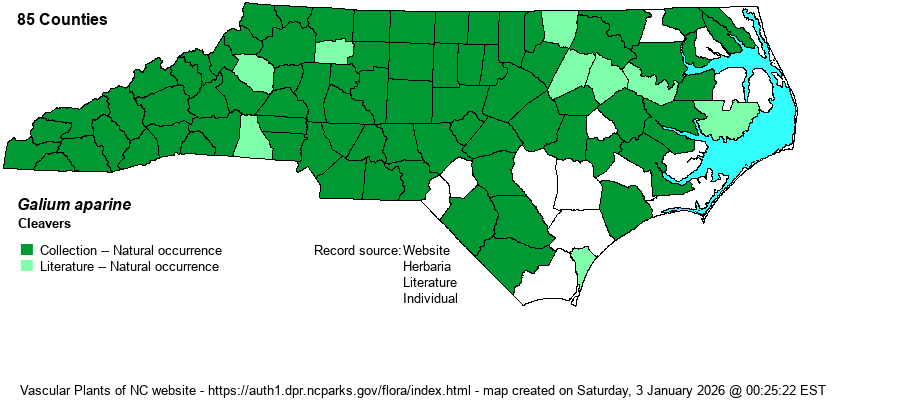| Author | L. | |
| Distribution | Essentially throughout, but scarce to absent near near the coast.
Widespread across the continent, though scarce in the southern half of FL. | |
| Abundance | Common to locally very common across the Mountains, Piedmont, and the western half of the Coastal Plain. Frequent in most of the Coastal Plain, but rare to absent close to the coast. | |
| Habitat | This has a wide array of habitats. It is most often found in rich soil of bottomlands and moist forested slopes, but it also occurs in some meadows, and disturbed areas. It favors moist to rich soil. It can be weedy on some forested slopes and bottomlands, especially where recent disturbances have occurred. | |
| Phenology | Blooms in April and May, and fruits soon after flowering. | |
| Identification | This is a vine-like herb with a weak stem that trails along the ground or leans on other vegetation; it reaches 2-3 feet long. This Galium has strongly retrorse hairs along the stem and is thus scabrous to the touch and painful if you run you fingers along the stem. The whorled leaves are usually in 8's (6-8), each leaf being linear to oblanceolate and about 1.5 inches long but only 1/6-inch wide. Clusters of tiny white flowers grow from the leaf axils. In this species, the fruits are small and bristly. This is a very familiar woodland species of moist soil, often sprawling over spring ephemeral wildflowers, and should be easily found at that season. | |
| Taxonomic Comments | None
| |
| Other Common Name(s) | Sticky-willy, Catchweed Bedstraw, Goosegrass. This is probably the only native Galium that does not have its most often used common name as "xxxxx Bedstraw". | |
| State Rank | S5 | |
| Global Rank | G5 | |
| State Status | | |
| US Status | | |
| USACE-agcp | FACU link |
| USACE-emp | FACU link |

